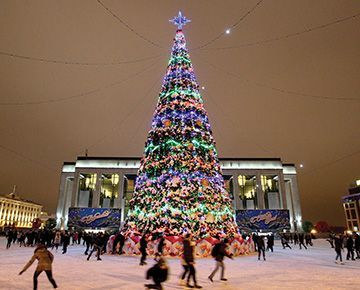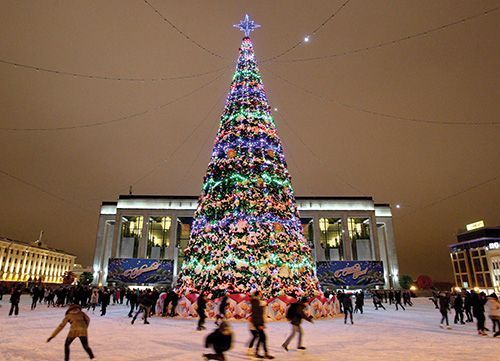
Іt’s said that the level of indulgence and enjoyment organized at the turn of the New Year will herald a similar style for the rest of the coming year. For Belarusians, it’s customary to watch Eldar Ryazanov’s film, The Irony of Fate (or Enjoy Your Bath!) and we regale ourselves with Olivier salad. We give free scope to our imagination in decorating our festive New Year’s table and place gifts under the tree, to delight the family. Certainly, we wish each other good luck and health as the chimes ring out. At this special time, between the hours of the year past and the new one, during this window of expectation, we believe that nothing can harm us and all failure will be left in the past. We feel unity not only with our family, but with all citizens of Belarus, who share in our wish for national prosperity. We also rejoice in the achievements reported by our President, Alexander Lukashenko, in his traditional TV speech.
Who knows who first decided to celebrate the New Year. Certainly, they must have observed the rhythms of nature, seeing its beginning and end, and enduring spirit of renewal. We share this thirst: perhaps it’s within our very DNA. As Thomas Mann, the German writer, said, nature knows no divisions to specify its flow. The New Year is greeted not by thunder or lightning. There is no roar of pipes to inform us of its approach. Only humans establish landmarks. According to the writer, even when a new century begins, only we mortals ring bells and fire pistols.
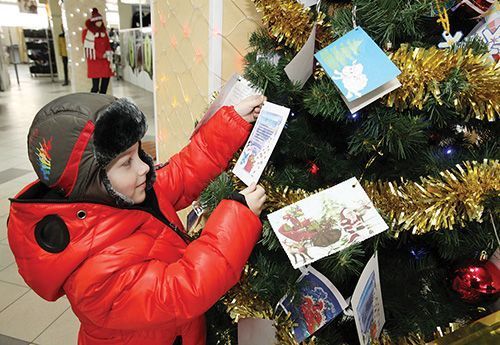
According to all-knowing Wikipedia, the tradition appeared in Mesopotamia, the well-known cradle of ancient civilization, 25 centuries ago. It appears that the New Year is the most ancient holiday, giving us a feeling of renewal, which we embrace with pleasure, continuing this ‘ageless’ tradition.
At various times, it has been celebrated in different ways in our country. Some traditions are very old, while some have appeared just recently. For example, Bolotnik (the marsh demon) recently came to ‘live’ in the Berezinsky Biosphere Reserve, having transformed from a malevolent force into a spirit of goodness. Our correspondent from Vitebsk writes about him in this edition, and the custom of Kolyady Tsars; nothing similar exists anywhere in the world. It goes back to the old times, marking the arrival of the New Year.
The ancestors of modern Belarusians celebrated the New Year during the vernal equinox. At that time, volochebniks (participants of the ritual) were popular, visiting peasants’ houses to delight people with singing, in return for receiving small gifts of bread, eggs, cheese and sausage. Such pagan traditions gradually disappeared from the life of our ancestors, as the power of the Christian Church grew, and the New Year festivities were transferred to Christmas, carrying over into January.
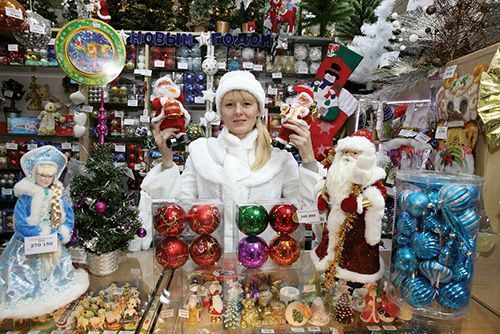
According to experts, the New Year fell at different times across various regions of Belarus. The territory known as part of the Grand Duchy of Lithuania celebrated on January 1st, in 1364. In eastern Belarus, from 1493 until 1700, the Byzantine Church tradition was marked in early autumn — on September 1st. In 1699, Peter I adopted a decree which assigned the beginning of the year to January 1st. Thus appeared the winter holiday of the New Year, when kolyadovshchiks (tireless actors who transformed into goats, bears and other animals, donning fancy dress) would visit each home to sing magnificent kolyada songs. Today, those from children’s amateur studios, and students of humanitarian colleges and institutions of higher education often take up the baton. I’ve seen this playful and stirring Kolyada custom performed at the Museum of Belarusian Literary History, by students of the Belarusian State University of Culture and Arts.
The ceremonial New Year’s table is considered especially solemn if there are 12 dishes. Our grandfathers and great-grandfathers believed that they would live during the rest of the year in the manner in which they celebrated on that night. Accordingly, every effort was made to adorn the table with rich foods and to maintain a happy mood. In contrast, kutia supper was eaten on Christmas Eve (boiled rice with raisins and honey).
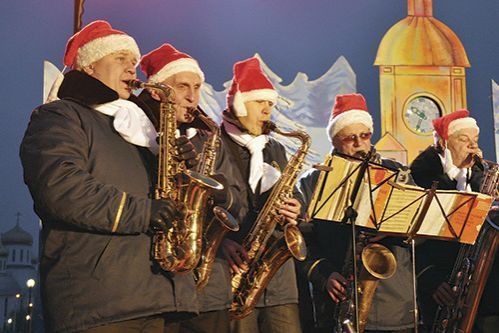
Adam Bogdanovich, the father of Belarusian poet Maxim Bogdanovich, describes the Christmas menu in his book I Aspired All My Life to Light:
‘…Old woman Ruzalya always kept and fattened a pig for Christmas. It speaks for itself: by Christmas, all meat-eaters would have fragrant sausages, slightly salted and peppered, with caraway seeds and marjoram, as well as polendvitsa (dried meat) and karkavina (served in a thick gut). Meat eaters would also be treated to blutwurst sausages with egg flour or groats, flavoured with finely chopped suet. There would be cereal sausage with suet and, by Easter, shynka (ham) and shoulder well salted and strewn with nitre and spices, protected from rotting, and polendvitsa smoked over spruce or juniper branches. There would be a tub of 2-3 pods of salted suet, to be eaten with potatoes, cabbage, beetroot and other foods. Christmastide would begin with obligatory pancakes, served with an aromatic and tasty ‘veraschchaka’ sauce. For those who do not know, I must explain that this wonderful dish is made of slices of sausage, suet and pork or brisket — chopped and slightly peppered, with a sauce from wheat flour. People dip pancakes into veraschchaka, having rolled them into tubes: simply marvellous. After six weeks of pilipovsky fasting, eating poor menus of mushrooms and oil, the appearance on the table of hissing and seductively smelling veraschchaka near a pile of pancakes covered by a towel is a solemn event of exclusive importance: the whole loss in weight will soon be restored!’
Of course, man cannot live by bread alone, as Adam Bogdanovich writes:
‘… during kolyada weeks (an ancient pre-Christian winter ritual), the evenings are sacred, with no work allowed: adults spend evenings in conversation, while young people play games and crack nuts and sunflower seeds. It is especially forbidden to sew or spin. During all these holiday-respites, simplified routine allows people complete rest and enough sleep, so that the exhausted body renews its energy, becoming strong enough to bear the hard labour of everyday life’.

Interestingly, during Christmastide, people tell fairy tales and discuss matters of interest not only to children, but adults. Adam Bogdanovich remembers these from his own childhood:
‘In grandmother’s hut, we solemnly celebrated: first Christmas Eve. It remains in my memory not only because there was a lot of tasty and various kinds of food, the abundance of which induced us to eat less in order to try each dish (although no less than three spoons, as ritual required) but because there was a shared mood of inspiration. I doubt that anything else is capable of arousing such feelings and imagination, raising religious emotions, as these primordial festivals of national belief, developed over many centuries. They cannot help but influence children’s minds’.
Fortune telling and other rituals accompanied the New Year’s holidays in Belarus, thought to ensure peace and prosperity for the coming year. One custom, widespread across some regions, was that of children joyfully running from home to home with a bag into which hosts placed gifts, in return for the children strewing the floor of the house with seeds of rye, barley and wheat. The ‘sowing’ ritual was thought to bring a good harvest.
I remember, in the mid-1960s, on the eve of the ‘old calendar’ New Year (January 13th-14th) in my Ukrainian childhood, in Kharkov Region, in the small town of Volchansk, there were cheerful kolyadovshchiks: our neighbours from Podgornaya Street. Two sisters who were dressmakers, Natasha and Marusya, painted their cheeks with bright red lipstick, as if reddened from frost (which usually reached minus 20 in the evening). Carpenter Fedya played Father Frost, with a red nose also painted in lipstick, and cotton wool stuck to his dense black eyebrows. They would strew us with grain, singing: ‘Let good be with you and with us, so that we are happy…’ It was a delight to take sweets and biscuits from a jar and place them in the enormous bags of the kolyadovshchiks, and then to run after our ridiculous visitors, to the entrance hall, to give them meat pies baked by grandmother, placing them directly in their hands. Those joyful moments of family life — my children’s amazement and delight and the sensation of great happiness over those Christmastide days — is as bright as a picture, stored in my memory.
Belarus had a ritual for strengthening friendship and mutual understanding in families. All members would sit at the festive table 20 minutes prior to the beginning of the New Year, placing a clay bowl of water in the middle of the table. Each person would stretch their left hand over the bowl for some time, passing all bad thoughts from the past year into the water. Afterwards, the water was poured into the snow, with all negative thoughts: a job conducted by the oldest member of the family. At midnight, the same bowl was filled with water, and the magic action was repeated with the right hand, while thinking only happy thoughts for health, good luck and prosperity. The bowl was passed round, clockwise, and everyone, including the children, took a sip, believing that all wishes would come true.
The desire for ‘renewal’ was accompanied by various rituals and prohibitions: repaying all debts (in order to enter the New Year without the burden of borrowing); saying goodbye to old things — as in Italy; cleaning the house; and buying new things. Belarusians are not alone in their desire for novelty and hopes for a better future: a quick Internet search brings forth many examples from around the world.
One Russian site talks about the ritual of fortune telling: ‘In Belarus, fans of folklore adore feeding cockerels by hands on this holiday. Unmarried girls line up before a hungry crowing bird and the first girl to whom the cock approaches, to peck grain, will be the first to marry’.
Even in space, astronauts observe a few New Year traditions, changing into the traditional costumes of Snow Maiden and Father Frost and amusing themselves with trying to catch Father Frost’s beard in zero-gravity. Although it’s impossible to raise a glass of champagne, the cosmonauts congratulate each other 16 times: according to the number of time zones in America and Russia.
These days, if you go shopping on January 1st in Minsk, you’re liable to receive a good discount, since this is thought to bring the seller luck and success in the coming year. I was favoured with such an honour, buying a gift for my son: a jacket.
Change is inevitable and this is true of the New Year traditions, with some losing their ‘magic’ and becoming no more than amusing games. We also have new, fantastic characters: Snow Maiden, Zima (winter) and other heroes of Belarusian national fairy tales have begun to accompany Father Frost.
The mythological ancestor of modern Belarusian Father Frost was Zyuzya, the pagan god of winter and severe cold, who was honoured until the 19th century. People would say: ‘When Zyuzya is outside, then kutia is on the table’. BelTA archives tell us that Belarusians imagined Zyuzya as a grey-haired, fat old man, with a short, shaggy beard, barefooted, without a cap, and carrying an iron mace. They believed that Zyuzya spent most of the winter in the forest, but would sometimes visit villages, bringing severe frost. When angry, Zyuzya would beat his mace upon a tree stump, bringing severe cold. On Kolyada night (an ancient pre-Christian winter ritual) people left out some kutia porridge for him, to gain his favour, or would throw the first spoon of porridge outside the window, saying: ‘Frost, come and eat kutia’.
Ancient Zyuzya settled in Belarusian Poozerie (a land of lakes) but now has his place of permanent residence in Postavy District, in Vitebsk Region. Zyuzya Poozersky is famous for his hospitality, greeting tourists from all over Belarus during the New Year festivities, bestowing them with hot herbal tea from a samovar, pancakes and spice-cakes baked to ancient recipes. However, as Sergey Golesnik tells us in his article this month, Zyuzya is currently ‘on leave’.
It seems likely that Belarusian Father Frost, as well as his colleagues abroad, such as Santa Claus, is inspired by Archbishop Nicholas, who lived in the days of the Byzantine Empire and who was said to render help to all in need. After his death, he was beatified as a Christian saint. December 19th is the day of Nicholas the Wonderworker, celebrated by believers in our country.
The 21st century has brought many innovations, such as a Christmas masked ball held annually at the National Academic Bolshoi Opera and Ballet Theatre (on the night of the ‘old calendar’ New year); tickets sell out in October, being popular not only among Minskers but among residents from other regions as well. Most guests wear fancy dress, giving the illusion of the simultaneous presence of different centuries. You are likely to meet Duke Vytautas and Duke Jogaila, characters from opera, and gallant officers in epaulettes waltzing with ladies in dresses from the time of Pushkin.
Agro-estates encourage guests to commune with nature and to try dishes prepared for the New Year or Christmas by our grandmothers, including ‘garezy’ potato pies with mincemeat, mushrooms and caraway seeds, fried in a mix of animal fat and vegetable oil. This tasty dish has proven popular at culinary festivals. Dostatok (prosperity) Estate, in the small Belarusian town of Disna, will be serving them to guests this year.
Increasingly often, residents from various regions take their children to visit Father Frost, in Belovezhskaya Pushcha national park. Meanwhile, over the last decade, it has become a tradition to put on charitable New Year shows for children — especially those without families of their own, and those from disadvantaged backgrounds, or with disabilities. The children’s response is magical to behold. Youngsters also love to gather around the country’s main fir tree, in Minsk, joined by the President of Belarus.
We all love the sight of a decorated fir tree, illuminated with twinkling lights, adorning squares and public gardens. They are also found in offices, supermarkets, and homes big and small, creating an atmosphere of anticipation. Minsk is beautiful during Christmas and the New Year, swathed in coloured lights, which are switched on for December 25th: the day on which Catholics celebrate Christmas. Orthodox believers wait for January 7th, observing six weeks of fasting. For those who prefer a natural fir tree, the markets offer a huge choice of forest beauties in various sizes. Minsk’s main tree is 33 metres in height, decorated in national style, and is already mounted on Oktyabrskaya Square. On the night of 31st December, when the clock approaches midnight, residents will gather to shout ‘hurrah!’ for the New Year.
By Mikhalina Cherkashina









